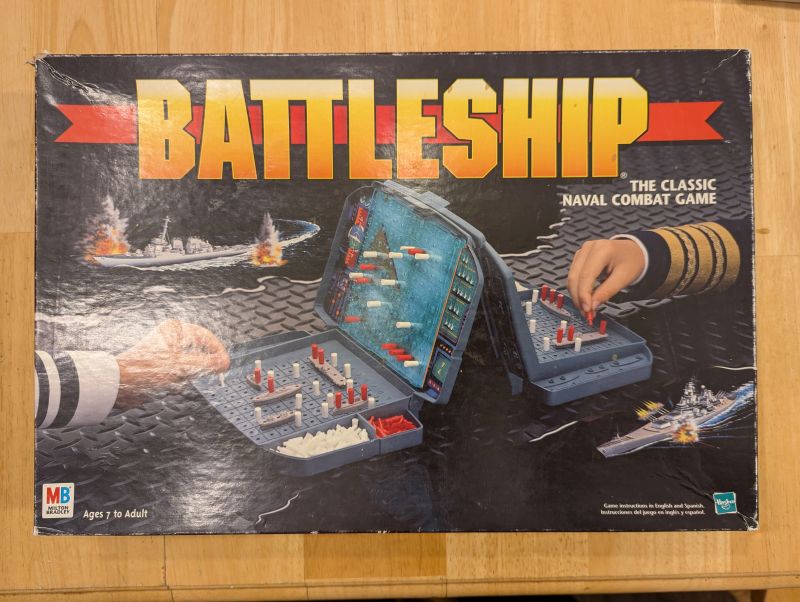
It’s been too long since I last posted a review! I have been playing board games, but unfortunately I just haven’t found the time to write about them. But no longer! Today’s review is for a foundational game: Battleship by Milton Bradley. Battleship is a classic guessing game with a small dose of strategy and bluffing, depending on who you are playing with. I played this back in late January (!) with my daughter.
Premise
The premise of this game is that each player is the commander of a naval fleet (this sounds familiar…) and is attempting to locate and destroy the other player’s ships before they can do the same. Each player has five ships of varying sizes and a places them in a secret arrangement on a hidden 10×10 grid. The players then take turns firing at a point on the grid, with the other player confirming whether the shot is a “hit” or “miss”. Once one player has sunk all of their opponent’s ships, they win!
Components
Quality: 2/5 (cheap molded plastic)
Quantity: 3/5 (there are a lot of hit/miss markers)
Organization: 5/5 (clear and easy)
This game has had many iterations over the years, but the components generally remain the same. Each player has a plastic dashboard that opens up like a clamshell and is supposed to resemble a radar display, with 10×10 grids on both the lower and upper portions, as well as places to store your ships and hit/miss pins on the lower. Aside from this, the only other components are the hit/miss pins (who knows how many) and five ship miniatures for each player.
Given that there are only really two types of components, organization is simple. Ships go into their special little spots on the left side of the clamshell, pins go into pockets on the right, and both clamshells fit nicely into the box, with a small tray for extra pins in the middle.
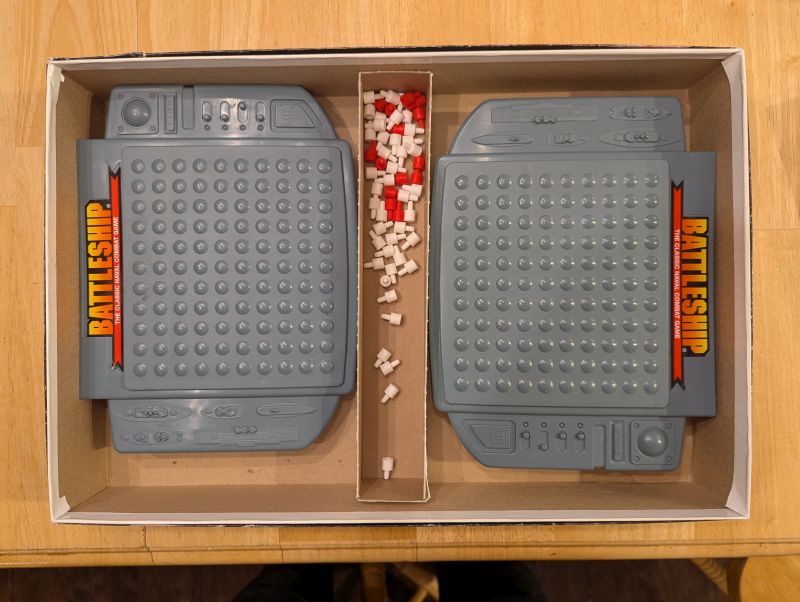
Setup
Complexity: 1/5 (very fast)
Footprint: 1/5 (play it anywhere)
The setup for Battleship may be the easiest I’ve ever seen. You literally just open up the display and place your five ships on the lower 10×10 grid. That’s it! You’re ready to play. Just make sure your opponent cannot see your display (and vice versa).
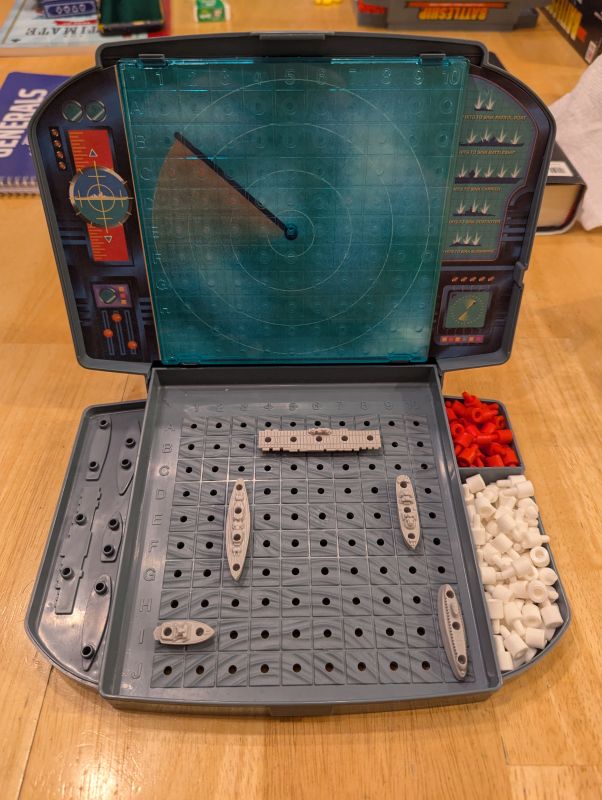
Rules
Players: 2
Time: 10-30 minutes (fairly quick, depends on the game)
The rules are as simple as the setup. Once both players are ready, they take turns calling out the coordinates they are firing at, with the other player telling them if it is a “hit” or a “miss”. Each 10×10 grid has the same coordinates: rows are letters (A-J) and columns are numbers (1-10). A typical back-and-forth would be something like “E1” and then “Miss!”, with each player tracking the results on their grid (the upper grid for the attacking player, the lower for the defending player) with a red pin for a hit or a white pin for a miss. Notably, the pins can be stacked if someone fires at the same location twice!
There is a small bit of strategy here, though, both in the arrangement of your own ships, as well as your method for searching for your opponent’s. I’m sure there is some optimal solution, but in my experience everyone has their own ever-evolving ideas on what is best and testing those out is half the fun. In this game, I chose to ensure that none of my ships overlapped by column, which seemed to work okay. To find ships, I generally like to separate my shots by 1-2 pins and include the sides, since most people like to hug the edges of the grid.
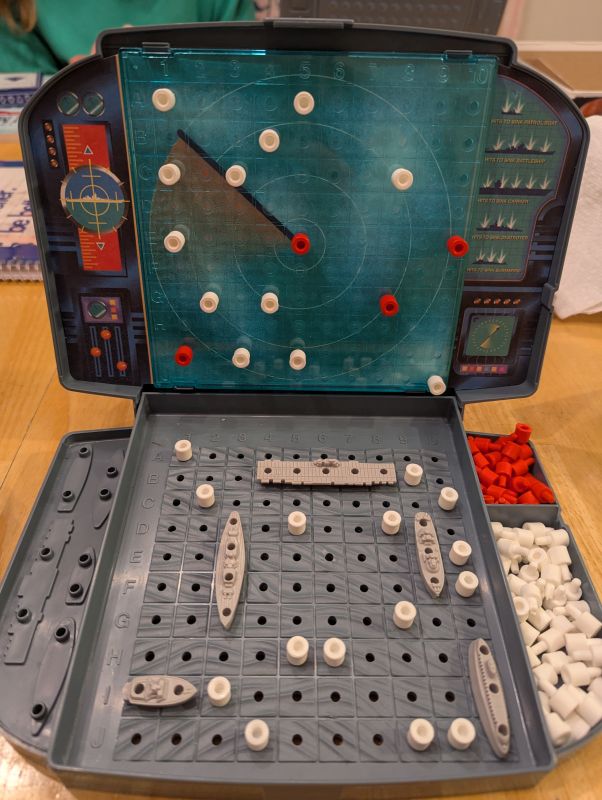
What I Liked
I do enjoy this game quite a bit; it’s approachable because it’s simple, but endlessly replayable because the players and their strategies always change. Plus, there’s almost an element of poker to it: does your opponent have a tell when you almost hit one of their ships? Do you?
What Could Be Better
I don’t really have any notes; the game is too simple for much tinkering. It’d be interesting to play a version with a larger grid, and maybe some mechanics to enrich the strategy elements, but then you’d lose all the benefits of its simplicity. Probably better to find a different game if that’s what you’re looking for.
Results
The Allensworth fleet prevailed this time. My daughter was able to sink two of my ships, but in the meantime I sunk her entire fleet with my proprietary ship-finding methodology (patent not pending).
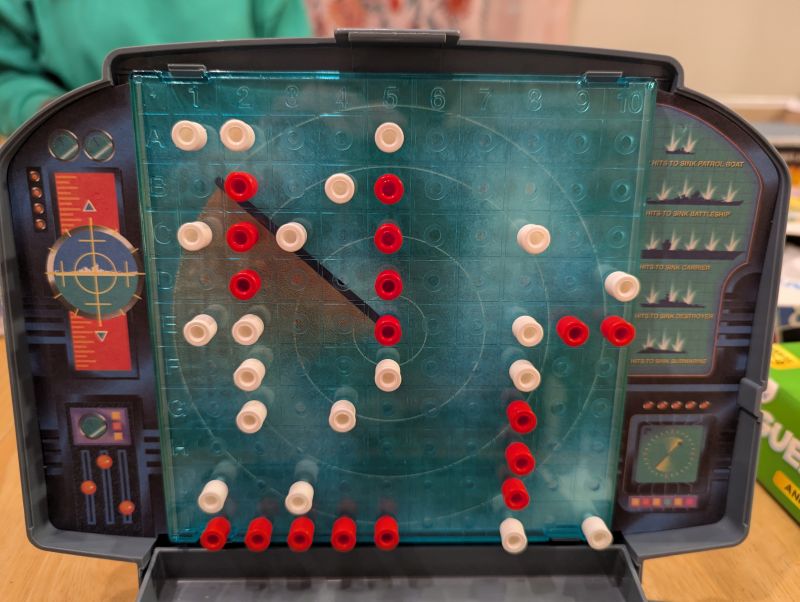
Recommendation
Age: 6+, Fun: 4/5
Replayability: 3/5 (can get old after 2-3 games in a sitting)
This game is a quick and easy guessing game that’s really great for playing with kids.